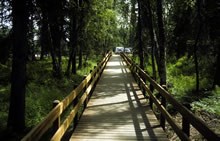
 Injury
Injury
Passive use is the service provided by natural resources to people that will likely not visit, contact, or otherwise use the resource. Thus, injuries to passive use are tied to public perceptions of injured resources. Passive use is the appreciation of the aesthetic and intrinsic values of undisturbed areas and the value derived from simply knowing that a resource exists. The oil spill occurred in what many Americans viewed as an undisturbed area and caused visible injury to shorelines, fish and wildlife. The loss to passive use following the oil spill was estimated by the State of Alaska at $2.8 billion. Using a contingent valuation approach, this was the median value that those surveyed were willing to pay to prevent a catastrophe similar to the Exxon Valdez Oil Spill from happening again.
Recovery Objective
Passive use will have recovered when people perceive that aesthetic and intrinsic values associated with the Spill area are no longer diminished by the Spill.
Recovery Status
The Trustee Council determined that passive use injuries occurred as a result of the Spill because natural resources including scenic shorelines, wilderness areas, and popular wildlife species, from which passive uses are derived, were injured. The key to the recovery of passive use is providing the public with current information on the status of injured resources and the progress made towards their recovery.
 Two vital components of the Trustee Council's restoration effort are the research, monitoring, and general restoration program and the habitat protection and acquisition program. Extensive work has been done to restore and monitor resources and communicate these findings to the public. The research, monitoring, and general restoration program is funded each year through the annual work plan, which documents the projects that are currently funded to implement restoration activities for injured resources and services. The habitat protection program preserves habitat important to injured resources through the acquisition of land or interests in land. As of 2006, the Council has protected more than 630,000 acres of habitat, including more than 1,400 miles of coastline and over 300 streams valuable for salmon spawning and rearing.
Two vital components of the Trustee Council's restoration effort are the research, monitoring, and general restoration program and the habitat protection and acquisition program. Extensive work has been done to restore and monitor resources and communicate these findings to the public. The research, monitoring, and general restoration program is funded each year through the annual work plan, which documents the projects that are currently funded to implement restoration activities for injured resources and services. The habitat protection program preserves habitat important to injured resources through the acquisition of land or interests in land. As of 2006, the Council has protected more than 630,000 acres of habitat, including more than 1,400 miles of coastline and over 300 streams valuable for salmon spawning and rearing.
Until the public no longer perceives that lingering oil is adversely affecting the aesthetics and intrinsic value of the Spill area, it cannot be considered recovered.
Because recovery of a number of injured resources is incomplete, the Trustee Council considers services related to passive use to be RECOVERING from the effects of the Spill.
Click HERE for more information on Trustee Council funded studies involving passive use.
